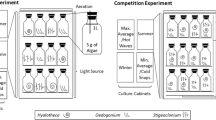Abstract
Gracilaria ferox J. Agardh was grown continuously in large, outdoor tanks under a pulse-fed nutrient regime for four years. Productivity ranged from 21.4 to 59.2 g d. wt m−2 d−1 with a mean of 39.7 g d. wt m−2 d−1 over the entire study period. Because the cultures were maintained under non-nutrient limiting conditions, productivity was regulated primarily by seasonal changes in light and temperature, which accounted for 75% of the variability of growth in algal yields. Salinity ranged from 31.0 to 36.5‰ and had insignificant effects on growth within this range. The original vegetative strain was maintained over the entire study without the need for additional supplementation from field-collected stock. Because of the pulse-fed nutrient supply, epiphytic growth on the target species was negligible (< 3% total biomass) throughout the study. The yields attained in this study rank among the highest reported for any intensively managed photosynthetic crop and demonstrate the feasibility of growing red macroalgae like Gracilaria at a sustained high yield in a large-scale, land-based culture system.
Similar content being viewed by others
References
Bird KT, Benson PH (1987) Seaweed Cultivation for Renewable Resources. Elsevier, Amsterdam. 381 pp.
Bugbee BG, Salisbury FB (1988) Exploring the limits of crop productivity. I. Photosynthetic efficiency of wheat in high irradiance environments. Plant Physiol. 88: 869–878.
Daugherty BK, Bird KT (1988) Salinity and temperature effects on agar production from Gracilaria verrucosa strain G-16. Aquaculture 75: 105–113.
DeBusk TA, Ryther JH (1984) Effects of seawater exchange, pH and carbon supply on the growth of Gracilaria tikvahiae (Rhodophyceae) in large scale cultures. Bot. mar. 27: 357–362.
Draper N, Smith H (1981) Applied Regression Analysis. Wiley Interscience, New York: 415–419.
Eppley RW (1972) Temperature and phytoplankton growth in the sea. Fish. Bull. 70: 1063–1085.
FAO (1996) Aquaculture Production Statistics 1985–1994. Food and Agriculture Organization of the United Nations. Fisheries circular No. 815. Rev. 8, Rome. 189 pp.
Goldman JC (1979) Outdoor algal mass cultures II. Photosynthetic yield limitations. Water Res. 13: 119–136.
Guillard RRL (1975) Culture of phyoplankton for feeding marine invertebrates. In Smith WL, Chaney MH (eds), Culture ofMarine Invertebrate Animals. Plenum Press, New York: 29–60.
Haglund K, Pedersén M (1993) Outdoor pond cultivation of the subtropical marine alga Gracilaria tenuistipata in brackish water in Sweden: growth, nutrient uptake, co-cultivation with rainbow trout and epiphyte control. J. appl. Phycol. 5: 271–284.
Hanisak MD (1987) Cultivation of Gracilaria and other macroalgae in Florida for energy production. In Bird KT, Benson PH (eds) Seaweed Cultivation for Renewable Resources. Elsevier, Amsterdam: 191–217.
Hanisak MD, Ryther JH (1986) The experimental cultivation of the red seaweed Gracilaria tikvahiae as an energy crop: an overview. In Barclay W, McIntosh (eds), Algal Biomass Technologies. J. Cramer, Berlin: 212–217.
Hansen JE (1984) Strain selection and physiology in the development of Gracilaria mariculture. Hydrobiologia 116/117: 89–94.
Hocking RR (1976) The analysis and selection of variables in linear regression. Biometrics 32: 1–50.
Huguenin JE (1976) An examination of problems and potentials for future large-scale intensive seaweed culture system. Aquaculture 9: 313–342.
Lapointe BE (1985) Strategies for pulsed nutrient supply to Gracilaria cultures in the Florida Keys: interactions between concentration and frequency of nutrient pulses. J. exp. mar. Biol. Ecol. 93: 211–222.
Lapointe BE, Rice DL, Lawrence JH (1984a) Responses of photosynthesis, respiration, growth, and cellular constituents to hypo-osmotic shock in the red alga Gracilaria tikvahiae. J. comp. Physiol. Biochem. 77: 127–132.
Lapointe BE, Ryther JH (1978) Some aspects of the growth and yield of Gracilaria tikvahiae in culture. Aquaculture 15: 185–193.
Lapointe BE, Tenore KR, Dawes CJ (1984b) Interactions between light and temperature on the physiological ecology of Gracilaria tikvahiae (Gigartinales: Rhodophyta). Mar. Biol. 80: 161–170.
Lapointe BE, Williams LD, Goldman JC, Ryther JH (1976) The mass outdoor culture of macroscopic algae. Aquaculture 8: 9–20.
Mann KH (1973) Seaweeds: their productivity and strategy for growth. Science 182: 975–981.
McLachlan J, Bird KT, Greenwell m (1986) Seaweed resources for the extractive industry: what are the options? Monogr. Biol. 4: 1–12.
Ryther JH (1977) Preliminary results with a pilot plant waste recycling marine aquaculture system. In D'Itri FM (ed.) Wastewater Renovation and Reuse. Marcel Dekker Inc., New York: 89–132.
Ryther JH, Corwin N, DeBusk TA, Williams LD (1981) Nitrogen uptake and storage by the red alga Gracilaria tikvahiae (McLachlan, 1979). Aquaculture 26: 107–115.
Ryther JH, DeBoer JA, Lapointe BE (1979) Cultivation of seaweeds for hydrocolloids, waste treatment and biomass for energy conversion. Proc. Int. Seaweed Symp. 9: 1–16.
Smith AH, Nichols K, McLachlan J (1984) Cultivation of seamoss (Gracilaria) in St. Lucia, West Indies. Hydrobiologia 116/117: 249–251.
Author information
Authors and Affiliations
Rights and permissions
About this article
Cite this article
Capo, T.R., Jaramillo, J.C., Boyd, A.E. et al. Sustained high yields of Gracilaria (Rhodophyta) grown in intensive large-scale culture. Journal of Applied Phycology 11, 143–147 (1999). https://doi.org/10.1023/A:1008077722769
Issue Date:
DOI: https://doi.org/10.1023/A:1008077722769




